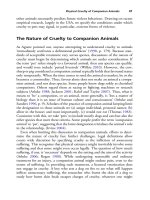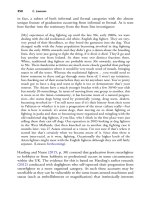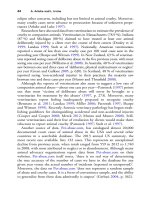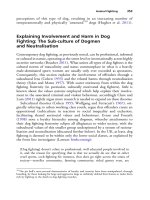The palgrave international handbook of a 190
Bạn đang xem bản rút gọn của tài liệu. Xem và tải ngay bản đầy đủ của tài liệu tại đây (36.97 KB, 1 trang )
Slaughterhouses
183
activity to continue largely unfettered and unquestioned. However, there are
other cultural and social mechanisms at play that support the rearing and
slaughter of animals for food. Weitzenfeld and Joy (2014, p. 21) refer to
these as ‘carnistic defences’ that ‘enable gross cognitive and affective distortions in order for human consumers to support the system’. It is our
contention that these various mechanisms work to normalise the animal
abuses that occur in the slaughterhouse (and in society more generally) and
that the concept of the animal industrial complex is a useful way of making
such mechanisms visible.
The Animal Industrial Complex
First discussed by Barbara Noske (1997) in a prescient book, Beyond
Boundaries: Humans and Animals, the term AIC picks up on the original
idea of a military-industrial complex, which was first used in a speech by
Eisenhower in 1961 to highlight the increasing problem of the connections
between government force and industry (Twine 2011). Throughout the
1970s, and beyond, this concept of interlocking institutions was extended
and is now commonly used to understand the prison-industrial complex, the
entertainment-industrial complex, and the pharmaceutical-industrial complex. The terminology is intended to problematise the overlapping interests
of capital accumulation and particular industries.
Specifically, the AIC is
a partly opaque and multiple set of networks and relationships between the
corporate (agricultural) sector, governments, and public and private science.
With economic, cultural, social and affective dimensions it encompasses an
extensive range of practices, technologies, images, identities and markets and
seeing it as a complex, integrated ideological system then opens the door to us
asking, for example ‘What networks are at play? How do they interconnect?
How are particular speciesist norms naturalised, carried and circulated? Why
are such norms so successful at recruiting adherents? (Twine 2011, p. 23)
Attempting to answer such questions allows us to highlight the complexity of
the systems of animal rearing and slaughter and to demonstrate the ideological support they have—support which renders them normative and thus
powerful.
The AIC and our related poor treatment of nonhuman animal species both
rest upon the idea that animals are ‘other’ to our humanity. They are not only
different, but categorically inferior. Binary worldviews invoke hierarchical









